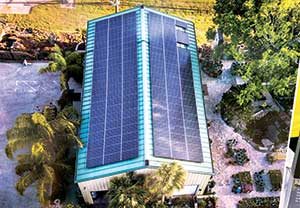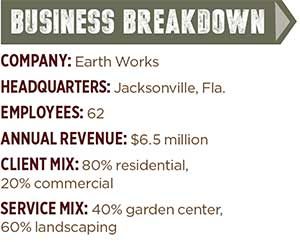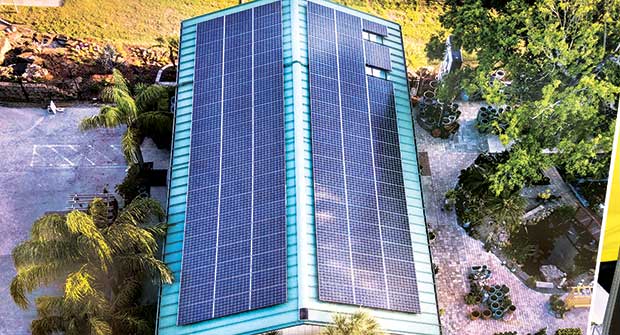
When Doug McGregor looked at adding solar panels to his landscape company five years ago, the return on investment (ROI) didn’t make sense.
The tax breaks were not guaranteed, and the cost of installation was high. Since that time, a lot has changed. In April 2018, Earth Works installed 124 new solar panels to its garden center and McGregor, president of the Jacksonville, Fla.-based company, says he may add even more. This time, he says, the numbers made perfect sense.
McGregor’s company invested $98,000 to install the panels, and he says that he’s looking at a seven- to nine-year ROI (weather depending) and that he secured a 30 percent tax break on top of it. With good financing from the bank, the project was a no-brainer, McGregor says.
“A salesperson from A1A Solar came to us, and (he) had all (his) ducks in a row—all the numbers made sense,” he says. “We went out to visit the facility and were very impressed. We didn’t even shop around. We were happy with what we saw.”

It took a little more than a week for the company to install the 36.6-kW photovoltaic system. The system produces an energy offset of 50,508 kilowatt-hours per year, which provides approximately 50 percent of Earth Works’ electric use. On a sunny day, McGregor says you can watch the meter turn one way—feeding electricity back to the grid. On a cloudy day, it’ll feed electricity back to the company. Earth Works’ electric bills have gone down 40 percent as a result.
Of course, now McGregor wishing for a lot of sunny days.
“We just had the wettest May since 1895, so it’s been more cloudy than sunny—but it’s still worth it,” he says. “Even if it took longer to get that full ROI, I would still do it. We’ve been really happy.”
McGregor says his customers care, too. The company’s garden center is highly visible from a main road, and McGregor estimates as many as 95,000 cars pass by the facility every day. He says that seeing the solar panels from the road is great PR for the company, which does its best to be environmentally conscious and a good neighbor.
In addition to the solar panels, the company has made other “green” moves before.
“When the recession hit in 2008 and my fuel bill went up to $12,000 a month, I realized how silly it was to drive around in a four-wheel drive truck getting 10 miles to the gallon,” he says. “I went from a big Chevy to a small Japanese vehicle—and that’s what I still drive today. It’s adapting to the times. You have to be flexible.”
McGregor says that even if the sight of the panels brings in one extra customer a day, it’s well worth it. He sees the addition of the panels as a differentiator, and he’s considering adding them to the parking lot via the use of car ports.
For other landscape firms considering a similar move, McGregor says if the numbers add up, there’s no reason not to go for it.
“When A1A came to us and said, ‘If we showed you a way to get free electricity would you be interested?’, I said, ‘Absolutely,’” McGregor says. “We believe electricity rates are only going to go up. This makes very good business sense for us. In seven to nine years, we’ll be getting free electricity. Why wouldn’t we take advantage of that?


